Supervisor Charles F. Peirce informs the Commissioner of Indian Affairs that Carlisle Indian School student Nancy Conners' mother is sick and needs her assistance. Second Assistant Commissioner C. F. Hauke forwards Peirce's telegram to Superintendent Moses Friedman.
Hauke, C. F.
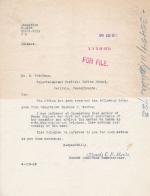
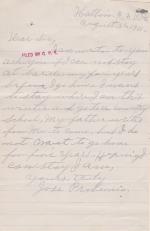
These materials include correspondence and reports from Supervisor of Indian Schools, Charles F. Peirce, listing 69 pupils as ineligible for enrollment at the Carlisle Indian School. Peirce recommended they be dismissed from the school as a result. Additional correspondence regards the circumstances of various students named in the report.…
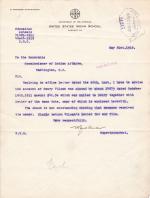
These materials include correspondence concerning the closure of the school bank account of Henry Vilcan.
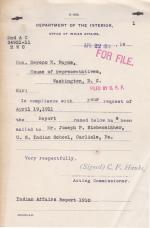
Representative Sereno E. Payne requests on behalf of Carlisle Indian School farmer, Joseph P. Siebeneicher, a copy of the last Annual Report of the Commissioner of Indian Affairs be forwarded to Siebeneicher.
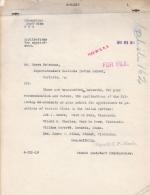
This material includes correspondence between Superintendent Moses Friedman and Assistant Commissioner C. F. Hauke concerning the appointment of former students to the Indian Service.
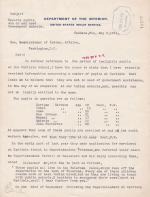
These materials include correspondence regarding students from Bent, New Mexico whose eligibility to attend Carlisle was questioned by Charles F. Pierce, Supervisor of Indian Schools. Pierce claimed the students had access to public schools and should be ineligible to receive an education at a government school. After an investigation, the…
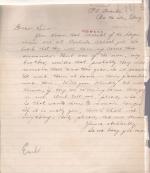
These materials include correspondence regarding an inquiry into on the return of the Hopi students enrolled at Carlisle in 1907. Ta wa hong yio ma was informed that the students were enrolled for five year terms and their periods of enrollment had not yet expired.
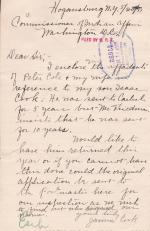
These materials include correspondence and legal documents regarding the request of James Cook to have his son Isaac Cook returned home from the Carlisle Indian School. Superintendent Moses Friedman initially sought to deny the request based on a claim that Isaac Cook desired to remain at the school. Friedman was overruled by the Office of…
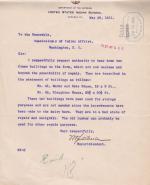
Carlisle Indian School Superintendent Moses Friedman requests to tear down the smoke and bake house and the slaughter house, both of which are used for storage on the farm and no longer needed due to improvements to the dairy barn. Second Assistant Commissioner of Indian Affairs C. F. Hauke grants permission.
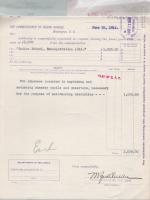
Carlisle Indian School Superintendent Moses Friedman requests to spend $1,000 from the "Indian School, Transportation 1912" account to capture and return runaway students and deserters. Second Assistant Commissioner of Indian Affairs C. F. Hauke denies Friedman's request because he wants Friedman to make individual requests instead.
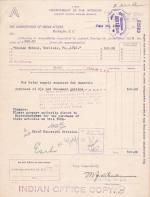
Carlisle Indian School Superintendent Moses Friedman requests to spend $500 from the "Indian School, Carlisle, Pa., 1912" account for water supply, and C. F. Hauke approves the request. A carbon copy of the request and receipt are included as well.
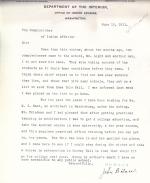
These materials include correspondence regarding a request by John B. Farr to remain at the Carlisle Indian School rather than being sent home for living near a public school. Farr desired to take a mathematics course at Conway Hall after studying at the office of an architect in Harrisburg, Pennsylvania. Farr hoped to further study…
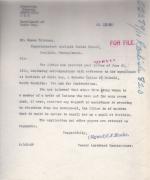
These materials include correspondence regarding a request to enroll Katie Ray, a member of the Catawba Nation, in the Carlisle Indian School. Ray's request was denied because the Catawba Nation had not recently received assistance in educating its youth from the Federal Government.
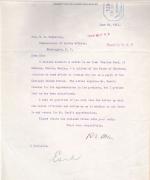
These materials include correspondence regarding an inquiry into the exclusion of Charles Geck from the Carlisle Indian School. Geck was released from the school as a result that he had access to public schools near his home in Oklahoma.
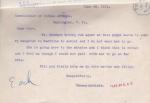
These materials include correspondence regarding a complaint made by Thomas Antiste that an employee of the Flathead School was attempting to force his daughter to enter the Carlisle Indian School.
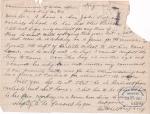
These materials include correspondence regarding a request by Mitchell Laughing to have his son John Laughing returned home from Carlisle. The request was denied on account of John's age and his stated desire to remain at the school on the outing program.
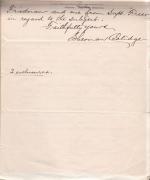
These materials include correspondence regarding a request from Rev. Sherman Coolidge to have his daughter Virginia Coolidge enrolled at the Carlisle Indian School. Coolidge required an exception from the Office of Indian Schools due to her young age.
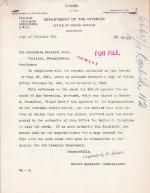
This material includes correspondence between The Merchants National Bank and the Office of Indian Affairs concerning the financial accounts of Amy Cornelius.

These materials include correspondence regarding a request to allow Adeline Boutang remain at the home of Marie A. Craighead under the outing system to continue nursing Craighead's mother. Boutang was training to be a nurse and had spent two years learning in the school hospital.
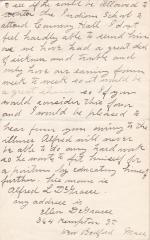
These materials include correspondence regarding a request from Ellen DeGrasse to have her son Alfred DeGrasse re-enrolled at the Carlisle Indian School in order to attend Conway Hall. DeGrasse had planned on attending Conway Hall before he returned home after recovering from surgery.
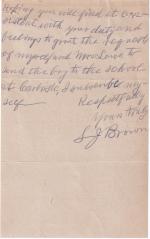
These materials include correspondence regarding a request from S. J. Brown to have an exception granted to his grandson so that he may be enrolled at the Carlisle Indian School despite being under the age of ten.
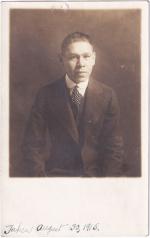
These materials include correspondence regarding a request by Moses P. Kogechiwan to enroll at the Carlisle Indian School as well as letters of recommendation.

These materials include correspondence regarding a request to have two children of Frank Tamer enrolled at the Carlisle Indian School. Tamer was assisted by two members of Congress in his request.
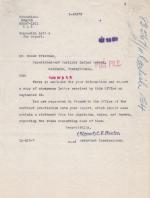
This document contains correspondence regarding an anonymous letter that was sent complaining of the conditions at the guardhouse, the hospital, and the school farm. The complaint discusses the treatment of Wesley Two Moons, who later dies at the school.
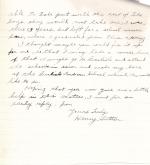
These materials include correspondence regarding requests for Henry P. Sutton to enter the Carlisle Indian School in order to take a commercial course. Sutton was initially due to his physical health but was later enrolled after paying his own transportation to the school.
